これから学ぶ人も、資格取得を目指す人も、最適なカリキュラムを選べます。
CTC 教育サービス
[IT研修]注目キーワード Python Power Platform 最新技術動向 生成AI Docker Kubernetes
こんにちはー。野田貴子です。今回も英語が苦手な方向けに海外の人気コラムを意訳したものをご紹介します。
VMwareの研修を検討されている方は、『VMware Education Partner of the Year 2017』を2年連続で受賞しているCTC教育サービスにどうぞ!
※VMware研修コース (https://www.school.ctc-g.co.jp/vmware/index.html)
2018年11月に公表しましたように、External Platform Services Controller(PSC)は廃止予定となっています。かつては多くのみなさまがEnhanced Linked Mode(ELM)やPSC HAなどの機能を利用するために、External PSCを導入してこられました。External PSCの削除にともない、VMwareは外部デプロイから組み込みデプロイへの移行を可能にするConverge Toolを提供いたします。Converge Toolを使用するためには、vSphere 6.5 Update 2d以上またはvSphere 6.7 Update 1以上を使用し、vCenter Server Appliance(VCSA)を実行している必要があります。
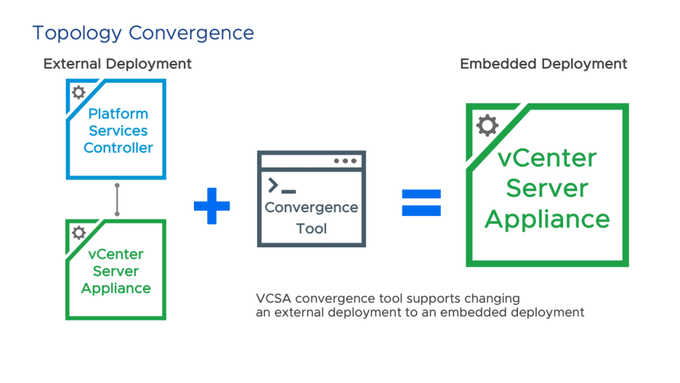
外部から組み込みのPlatform Servicesコントローラーへの移行を実行する前にまず最初に必要な作業は、現在のSSOドメインを分析して、これから取り扱うソリューションとサーバーを理解することです。SSO環境を確認し、NSXやSite Recovery Manager(SRM)など、SSO Lookup Serviceに登録されているソリューションを確認する必要があります。コンバージェンスが完了しましたら、上記および他のソリューションを手動で組み込みvCenter Serverに再設定します。どのソリューションがSSOサーバーに登録されているか不明な場合は、こちらのKB2043509を使用して、SSO検索サービスに登録されているサービスを確認することができます。
また、vCenter ServerがどのPlatform Services Controllerを指しているのか不明な場合は、次の2つの方法で確認することができます。1つ目の確認方法は、vSphere Clientを利用してAdvanced Settingsを確認することです。vCenter Serverに移動して、Configurationタブを選択します。Advanced Settingsに進みconfig.vpxd.sso.admin.urlを検索すると、接続されているPSCが表示されます。
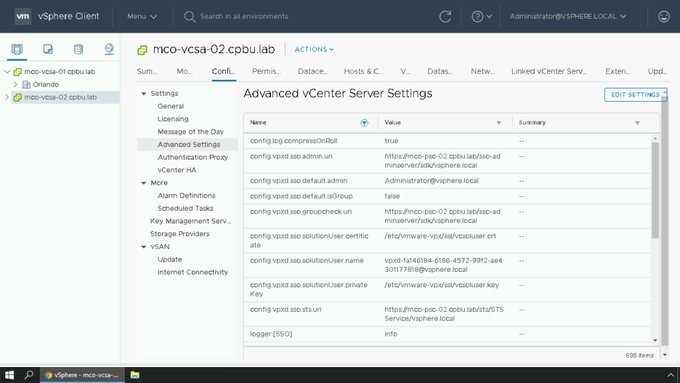
CLIの方を使用されたい場合は、次のコマンドを実行すると接続されているPSCを確認することができます。
/usr/lib/vmware-vmafd/bin/vmafd-cli get-ls-location --server-name localhost
また、NSX Managerにログインして現在どの外部PSCとvCenter Serverに登録されているかも確認できます。
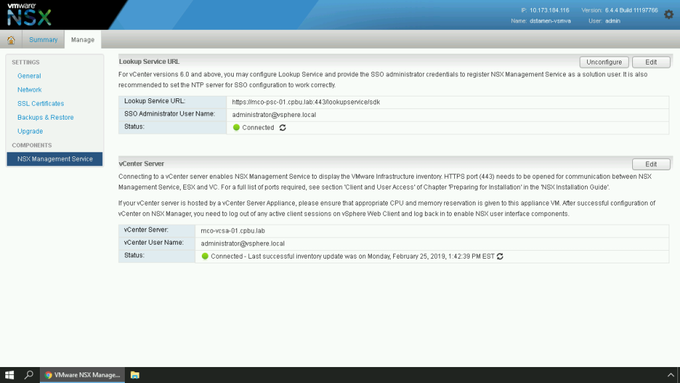
サンプルの環境では、こちらの図のようなアーキテクチャーになっています。この時点では、組み込みリンクモードになっている2つの外部PSCと、2つの外部vCenter Serverが備わっています。また、2つのNSX Managerインスタンスが外部PSCに登録されており、Converge Toolを実行した後に再登録する必要があります。
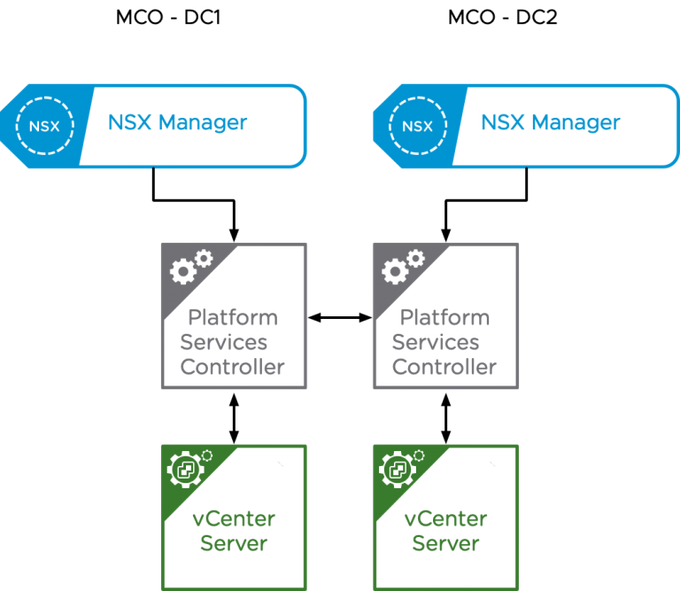
対象となる環境の計画を立てたら、Converge Toolの実行を見ていきましょう。現在vSphere 6.5およびvSphere 6.7で使用されているVCSA CLIベースのインストーラに慣れている場合は、Converge Toolも同じように感じることでしょう。Converge Toolを実行するには、VCSA isoをダウンロードしてマウントし、そしてまずJSONテンプレートを準備する必要があります。1つ目のテンプレートはConverge Toolを実行して外部PSCから組み込みPSCに移行するためのものです。2つ目は外部PSCを廃止するために使用されるもので、これは外部PSCをシャットダウンして SSOドメインから削除します。

最初はコンバージテンプレートです。このテンプレート内には4つのセクションがあります。
{
"__version": "2.11.0",
"__comments": "Template for VCSA with external Platform Services Controller converge",
"vcenter": {
"description": {
"__comments": [
"This section describes the vCenter appliance which you want to",
"converge and the ESXi host on which the appliance is running. "
]
},
"managing_esxi_or_vc": {
"hostname": "<FQDN or IP address of the ESXi or vCenter on which the vCenter Server Appliance resides.>",
"username": "<Username of a user with administrative privilege on the ESXi host or vCenter Server. For example 'root' for ESXi and 'administrator@<SSO domain name>' for vCenter >",
"password": "<Password of the administrative user on the ESXi host or vCenter Server. If left blank, or omitted, you will be prompted to enter it at the command console during template verification.>"
},
"vc_appliance": {
"hostname": "<FQDN or IP address of the vCenter Server Appliance>",
"username": "administrator@<SSO domain name>",
"password": "<vCenter Single Sign-On administrator password. If left blank, or omitted, you will be prompted to enter it at the command console during template verification.>",
"root_password": "<Appliance root password. If left blank, or omitted, you will be prompted to enter it at the command console during template verification.>"
},
"ad_domain_info": {
"__comments": [
"Important Note: This section is needed only when PSC (Platform Services Controller) appliance is joined to a domain.",
"Remove this section if PSC appliance is not joined to a domain.",
"Keeping this section without valid values results in JSON validation errors."
],
"domain_name": "<Domain name of the Platform Services Controller appliance's AD domain>",
"username": "<AD domain username with privileges to join any machine to the provided domain>",
"password": "<AD domain password with privileges to join any machine to the provided domain>",
"dns_ip": "<DNS IP which resolves AD domain name. This is an optional field and is required only when the provided AD domain cannot be resolved by the existing DNS setting of the VCSA node.>"
}
},
"replication": {
"description": {
"__comments": [
"Important Note: Make sure you provide the information in this section very carefully, as this changes the replication topology.",
"Refer to the documentation for complete details. Remove this section if this is first converge operation in your setup.",
"This section provides details of the PSC node which will be set up as a replicated node for a new PSC on the target VCSA node."
]
},
"partner": {
"hostname": "<FQDN or IP address of the target VCSA PSC node>"
}
}
}JSONテンプレートフィールドの機能の解説の次は、準備済みコンバージテンプレートの外観を確認しましょう。こちらの例では、最初の外部デプロイはActive Directoryに参加していませんが、SSOドメインで最初にコンバージしているので、記入するセクションは2つのみです。
{
"__version": "2.11.0",
"__comments": "Template for VCSA with external Platform Services Controller converge",
"vcenter": {
"description": {
"__comments": [
"This section describes the vCenter appliance which you want to",
"converge and the ESXi host on which the appliance is running. "
]
},
"managing_esxi_or_vc": {
"hostname": "mco-vcsa-01.cpbu.lab",
"username": "administrator@vsphere.local",
"password": "VMware1!"
},
"vc_appliance": {
"hostname": "mco-vcsa-01.cpbu.lab",
"username": "administrator@vsphere.local",
"password": "VMware1!",
"root_password": "VMware1!"
}
}
}2番目の外部デプロイもActive Directoryに参加していませんでした。すでに1つの組み込みvCenter Serverがあるため、Replication Partnerとして指定する必要があります。これを空白のままにすると外部PSCへのレプリケーションが自動的に作成されるため、それらを廃止したときは、レプリケーションがないために2つの別々のSSOドメインが作成されてしまいます。
{
"__version": "2.11.0",
"__comments": "Template for VCSA with external Platform Services Controller converge",
"vcenter": {
"description": {
"__comments": [
"This section describes the vCenter appliance which you want to",
"converge and the ESXi host on which the appliance is running. "
]
},
"managing_esxi_or_vc": {
"hostname": "mco-vcsa-02.cpbu.lab",
"username": "administrator@vsphere.local",
"password": "VMware1!"
},
"vc_appliance": {
"hostname": "mco-vcsa-02.cpbu.lab",
"username": "administrator@vsphere.local",
"password": "VMware1!",
"root_password": "VMware1!"
}
},
"replication": {
"description": {
"__comments": [
"Important Note: Make sure you provide the information in this section very carefully, as this changes the replication topology.",
"Refer to the documentation for complete details. Remove this section if this is first converge operation in your setup.",
"This section provides details of the PSC node which will be set up as a replicated node for a new PSC on the target VCSA node."
]
},
"partner": {
"hostname": "mco-vcsa-01.cpbu.lab"
}
}
}これでJSONテンプレートが正しく記入されましたので、テンプレートの実行に進みましょう。最初のvCenter Serverに対してConverge Toolを実行し、SSOドメイン内のすべてのvCenter Serverが完成するまで続けます。SSOドメイン内の残りのすべてのvCenter Serverが組み込みに統合されるまでは外部PSCを廃止することはできません。
Converge Toolで利用可能なすべてのパラメータを理解するために、次のコマンドを実行していろいろ見ておきましょう。
.\vcsa-converge-cli\win32\vcsa-util.exe converge --help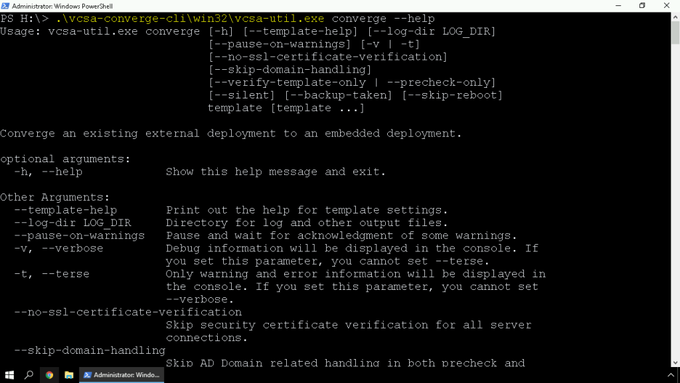
vCenter Serverに対してConverge Toolを実行するには、次のコマンドを実行します。
※ Convergeツールは一度に1つのvCenter Server Applianceに対してのみ実行できます。
.\vcsa-converge-cli\win32\vcsa-util.exe converge --no-ssl-certificate-verification --backup-taken C:\pathtofile.json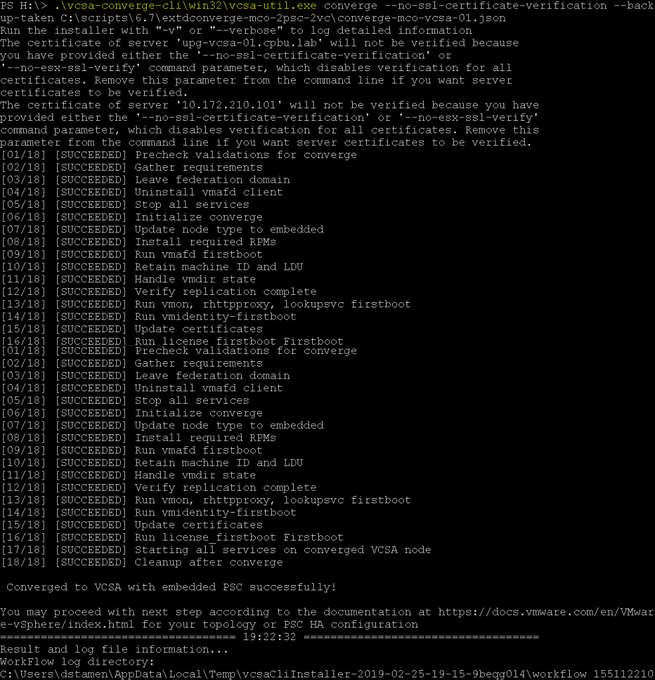
この段階で環境はすでに統合され、2つの外部vCenter Serverがありますが、NSX Managerはまだ外部PSCを指しています。
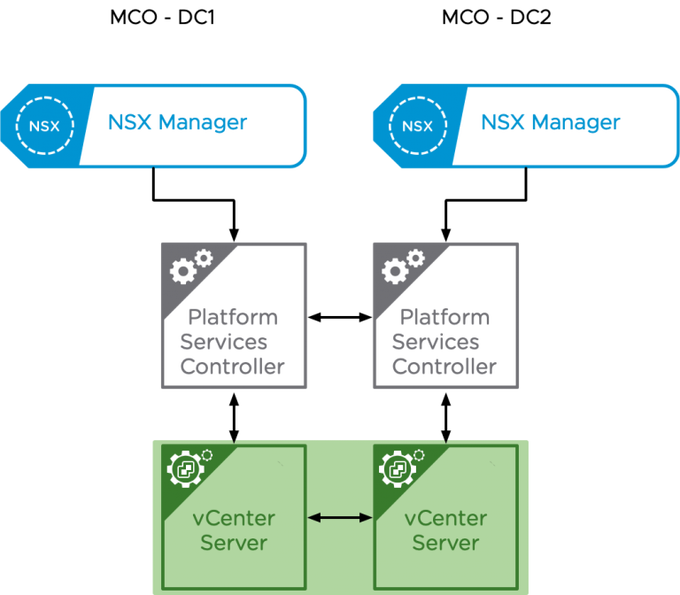
この登録を修正するには、NSX Managerにログインしてルックアップサービスを新しい組み込みvCenter Serverに再登録する必要があります。
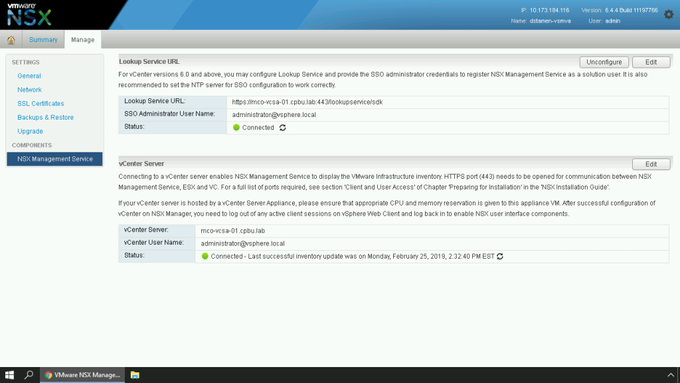
これで外部ソリューションは正しく登録されましたので、外部PSCを廃止して先に進むことができます。
※ SSOドメイン内のすべてのvCenter Serverが組み込みデプロイに移行されるまで、外部PSCを廃止することはできません。
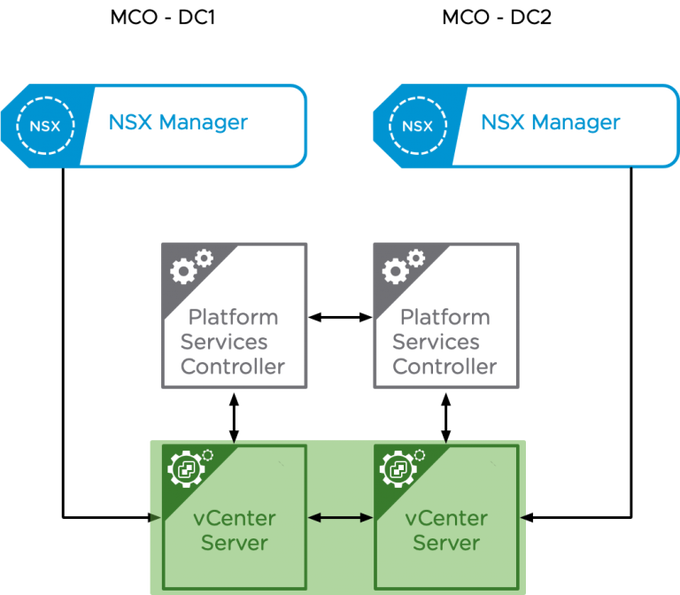
次に、廃止用のテンプレートを確認します。このテンプレート内には4つのセクションがあります。
{
"__comments": "Template for decommissioning PSC node with converge CLI tool.",
"__version": "2.11.0",
"psc": {
"description": {
"__comments": [
"This section describes the PSC appliance which you want to",
"decommission and the ESXi host on which the appliance is running. "
]
},
"managing_esxi_or_vc": {
"hostname": "<FQDN or IP address of the ESXi or vCenter on which the Platform Services Controller appliance resides.>",
"username": "<Username of a user with administrative privilege on the ESXi host or vCenter Server. For example 'root' for ESXi and 'administrator@<SSO domain name>' for vCenter >",
"password": "<Password of the administrative user on the ESXi host or vCenter Server. If left blank, or omitted, you will be prompted to enter it at the command console during template verification.>",
"port": "This section may be removed, if default port is 443. If not, custom port have to be specified"
},
"psc_appliance": {
"hostname": "<FQDN or IP address of the Platform Services Controller appliance>",
"username": "administrator@<SSO domain name>",
"password": "<vCenter Single Sign-On administrator password. If left blank, or omitted, you will be prompted to enter it at the command console during template verification.>",
"root_password": "<Appliance root password. If left blank, or omitted, you will be prompted to enter it at the command console during template verification.>"
}
},
"vcenter": {
"description": {
"__comments": [
"This section describes the embedded vCenter appliance which is in ",
"replication with the provided PSC"
]
},
"managing_esxi_or_vc": {
"hostname": "<FQDN or IP address of the ESXi or vCenter on which the vCenter Server Appliance resides.>",
"username": "<Username of a user with administrative privilege on the ESXi host or vCenter Server. For example 'root' for ESXi and 'administrator@<SSO domain name>' for vCenter >",
"password": "<Password of the administrative user on the ESXi host or vCenter Server. If left blank, or omitted, you will be prompted to enter it at the command console during template verification.>",
"port": "This section may be removed, if default port is 443. If not, custom port have to be specified"
},
"vc_appliance": {
"hostname": "<FQDN or IP address of the vCenter Server Appliance>",
"username": "administrator@<SSO domain name>",
"password": "<vCenter Single Sign-On administrator password. If left blank, or omitted, you will be prompted to enter it at the command console during template verification.>",
"root_password": "<Appliance root password. If left blank, or omitted, you will be prompted to enter it at the command console during template verification.>"
}
}
}こちらは廃止用に用意したJSONテンプレートの例です。
{
"__comments": "Template for decommissioning PSC node with converge CLI tool.",
"__version": "2.11.0",
"psc": {
"description": {
"__comments": [
"This section describes the PSC appliance which you want to",
"decommission and the ESXi host on which the appliance is running. "
]
},
"managing_esxi_or_vc": {
"hostname": "mco-vcsa-01.cpbu.lab",
"username": "administrator@vsphere.local",
"password": "VMware1!"
},
"psc_appliance": {
"hostname": "mco-psc-01.cpbu.lab",
"username": "administrator@vsphere.local",
"password": "VMware1!",
"root_password": "VMware1!"
}
},
"vcenter": {
"description": {
"__comments": [
"This section describes the embedded vCenter appliance which is in ",
"replication with the provided PSC"
]
},
"managing_esxi_or_vc": {
"hostname": "mco-vcsa-01.cpbu.lab",
"username": "administrator@vsphere.local",
"password": "VMware1!"
},
"vc_appliance": {
"hostname": "mco-vcsa-01.cpbu.lab",
"username": "administrator@vsphere.local",
"password": "VMware1!",
"root_password": "VMware1!"
}
}
}残りの各ノードについて繰り返し、外部PSCを削除するために廃止オプションを使用してConverge Toolを実行します。
.\vcsa-converge-cli\win32\vcsa-util.exe decommission --no-ssl-certificate-verification C:\pathtofile.json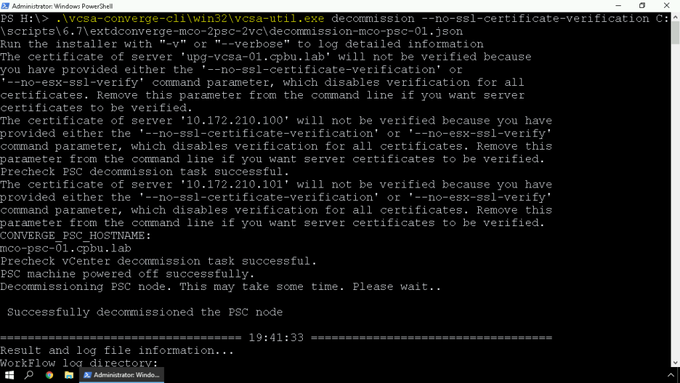
この時点で、Converge Toolを使用してすべての外部PSCが組み込みPSCに移行され、外部PSCは廃止され、以下に示すように、適切なデプロイになりました。
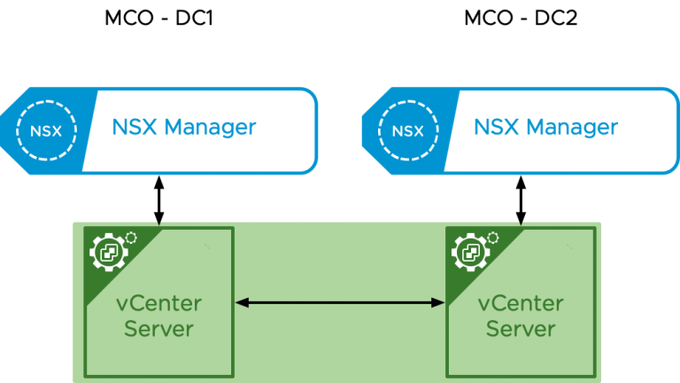
VMwareは外部PSCの廃止を発表いたしました。みなさまはできる限り早く組み込みPSCデプロイへの移行を開始してくださるようお願いします。組み込みデプロイはアーキテクチャの観点からだけでなく、管理するサーバーの数が減ることで、環境へのパッチ適用、アップグレード、そして管理が簡素化されます。このブログが、みなさんの環境でConverge Toolを正しく計画・実行する準備を整えられたことを願っています。
※引用元 https://blogs.vmware.com/vsphere/2019/02/understanding-the-vcenter-server-converge-tool.html
※本コラムはVMware社が公式に発表しているものでなく、翻訳者が独自に意訳しているものです。
[IT研修]注目キーワード Python Power Platform 最新技術動向 生成AI Docker Kubernetes